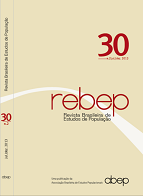Efeitos da migração sobre o crescimento populacional de longo prazo das províncias cubanas
Palavras-chave:
Cuba, Migração internacional, Migração interna, Variável-r, População estável, Crescimento populacionalResumo
Cuba é um país que, além de apresentar níveis de fecundidade inferiores ao nível de reposição, tem registrado um saldo migratório líquido negativo significativo. Observa-se também um intenso fluxo migratório interno, cujo padrão é bastante diferente nas diversas províncias do país. Devido à magnitude destes fluxos migratórios, a migração apresenta-se como um componente demográfico importante na dinâmica populacional cubana. Assim, o objetivo deste trabalho é estimar o efeito das migrações interna e internacional sobre o potencial de crescimento de longo prazo de Cuba e de suas províncias. Para tanto, foram calculadas medidas de reprodução e de crescimento populacional a partir dos métodos demográficos convencionais e da metodologia proposta por Preston e Wang (2007), que se baseia nos métodos da variável-r. Levando em conta o padrão demográfico atual, observa-se, na maioria dos territórios de Cuba, uma redução substantiva na capacidade de reposição das gerações e no tamanho futuro da população quando se consideram os efeitos da migração.Downloads
Downloads
Publicado
Como Citar
Edição
Seção
Licença
Os artigos publicados na Rebep são originais e protegidos sob a licença Creative Commons do tipo atribuição (CC-BY). Essa licença permite reutilizar as publicações na íntegra ou parcialmente para qualquer propósito, de forma gratuita, mesmo para fins comerciais. Qualquer pessoa ou instituição pode copiar, distribuir ou reutilizar o conteúdo, desde que o autor e a fonte original sejam propriamente mencionados.

